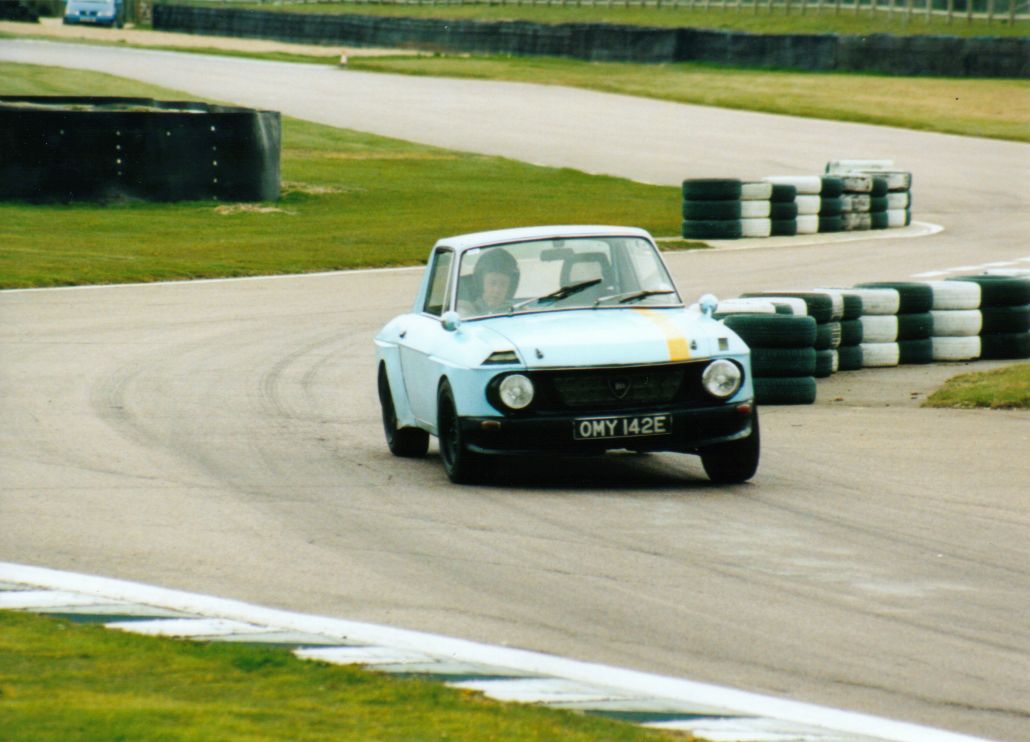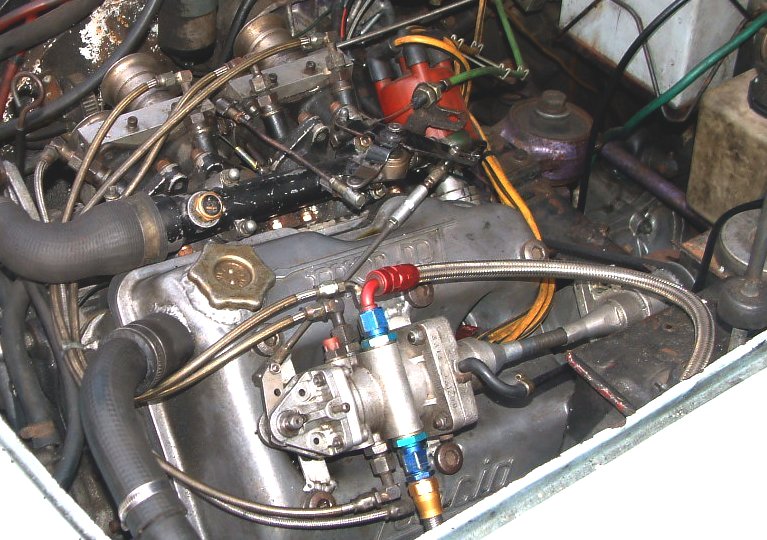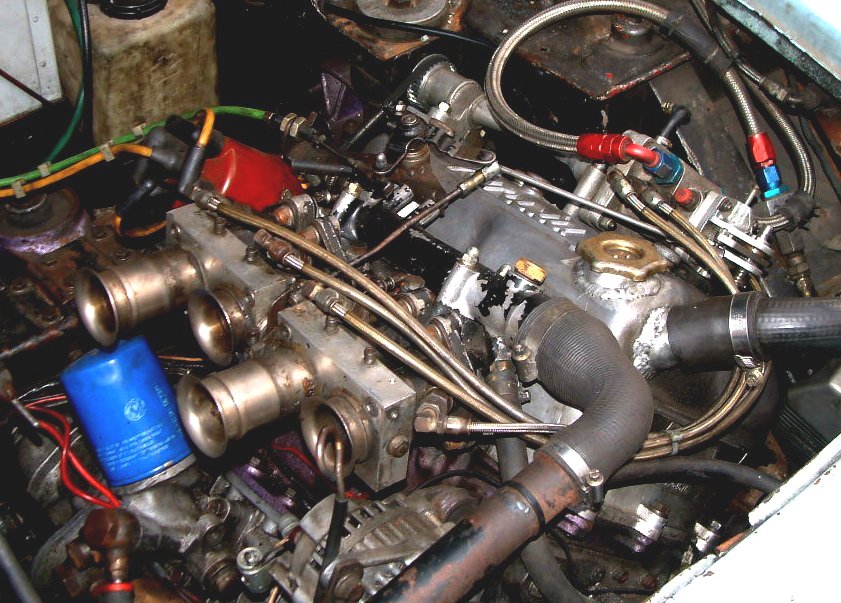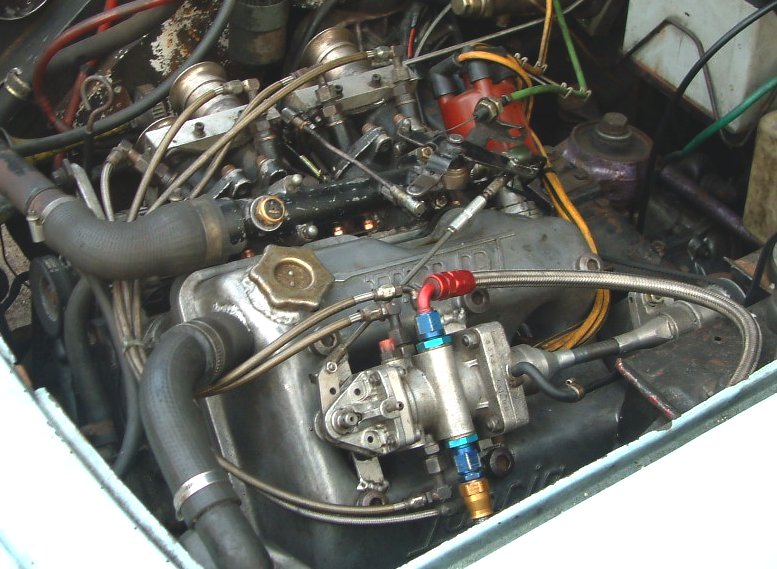|
|
Lancia Fulvia
Owner: Paul de Raymond Leclercq

At
the recent Castle Combe track day, my car finally made its appearance after what
seems to have been an interminable gestation period (seven years).
It
is not and never will be, finished.
However,
following an all too brief spell on the track due to a faulty condenser and a
cracked cylinder block (which was due to my negligence!) many visitors expressed
interest in the car. For me, an inveterate fiddler and modifier,
this was very satisfying, as I am aware that specials are, to say the
least, not nearly as much "the thing" as they were in Julian Jane's
day.
Anyway,
this piece is neither to be a cri-de-coeur
nor a tedious account of every weld or piece of fabrication until the triumphant
day when the car "passed its MoT with flying colours" - why do they
always say that? (it did actually).
No,
apart from a few disconnected jottings, I just wish to express my grateful
thanks to the many kind friends who have helped and also to the numerous
motor-manufacturers whose designers (unwittingly) contributed parts. These I
list at the end.
And
now a little about the project
·
Thanks to Gerald Batt
and Harry's neighbours, the Deadmans, I was able to collect OMY 142E from
Harry's premises after his death
·
25% filler, the balance
being mostly oily filth, holes, cobwebs etc.
·
After about three months
of weekends welding, I had a shell.
·
Since the project was
not done "aircraft-style" - i.e. drawings first (I can't draw) it
developed organically. Examples of this include the purchase of various steel
wheelarches, the three different mounting-places for the oil-cooler, two
mountings for the injection, three radiators etc.
·
Why injection? A number
of people asked me this at 'Combe.
was,
of course, aware of the works efforts with the Kugelfischer system, but no-one's
ever told me how much power was obtained. There are rumours that such a 1600
came to England but after fifteen years of Lancias I have yet to meet anyone who
has seen a VAR 1016 Fulvia, let alone an Iniezione!
Anyway,
I was very fortunate to be offered a Lucas 6mm 4-cylinder unit with a Cosworth
drive and 4 injectors at a price I could afford, so then I was committed. For
those who have not seen the car, the pictures show how the installation is
arranged, The metering unit is driven by means of a toothed belt from a modified
rev-counter drive.
tract
still further. The reason is that a shorter tract will improve top-end power and
together with injection, provide much-improved throttle response - never the
Fulvia's strong point. Additionally, injection provides superior atomisation of
the intake charge - essential with long ports - and thereby additional
mechanical "octanes" by virtue of a better burn.
At
a recent rolling-road test, the engine delivered 110 b.h.p.(and climbing) at the
wheels at 6700 r.p.m. Unburned hydrocarbons were very low - 95 p.p.m. proving
the "burn" theory. Incidentally the power output is equivalent to
about 145 b.h.p. at the flywheel. I am still using the original Cosworth F2 fuel
cam which came with the injection which is hardly suitable, whilst the ignition
timing is actually a guess - we didn't touch it during the test session - there
wasn't time; neither has the cam timing been addressed.
·
More work has to be done
on the exhaust system. I have found that Fulvias respond very favourably to
attention in this area. This may seem a platitude, but take a look at the dismal
exhaust valve-throat area on a standard Fulvia head and I'm sure you'll agree.
Another thing: why did Lancia use the 1300 manifold on the 1600? The fact that
stainless steel was used is really an admission of failure - I've seen them
red-hot! The fact that I have virtually to dismantle the entire front of my car
to remove my fabricated 4-into-1 manifold is another admission altogether of
course! There's really very little room; back to the (virtual!) drawing-board, I
suppose.
the
"A" post into the sill structure with further triangulation of the
flitches forward and above, that. I have done away with the troublesome boxes by
simply removing the rear portion of the sub-frame and mounting it where Nature
(and Fessia) intended - in the original place; a lot of work, but weight is
saved and rigidity gained. There are solid bushes (from Barry Waterhouse) and my
ball-race front spring mounts beautifully executed by Doug Ellis.
·
Next? Well, how about a
mechanical fuel-pump (always the Lucas bugbear) dry sump, rose-jointed outer
front anti-roll bar mounts, alloy brake-disc bells etc? It's nice to dream...
paintwork.
As I said, it will never be finished.......
SPECIFICATION
Body/Structure
1967 Fulvia Coupe. Sills reinforced with central membrane, all seam-welded. Sub-frame boxes removed, triangular sections rebuilt in 12/16g steel, seam welded. Rear of sub-frame removed. Sub-frame modified to use 2000 rear mounts. Gearbox tunnel removed and replaced with extended SII tunnel, triangulated to scuttle. Centre and rear sub-frame mounts triangulated with square tubing. Front flitch panels triangulated to "A" post. Wheel arches seam-welded to wing tops. New wings and rear panel fabricated from 18g aluminium sheet - riveted in place. Rear quarter lights removed and welded up. New front panel fabricated; front valance replaced with modified Porsche spoiler. Dash panel replaced with tubular structure; steering column lowered.Engine
82
x 75mm, 1584cc. Block bored & sleeved; flywheel lightened; head gas-flowed;
40mm inlet valves, 35mm exhausts.
c.r.
approx 11.5/1. Ex-works rally-profile camshafts(BWE) timing approx 50/70/70/50;
lift at TDC: 4.3mm
Lucas
mechanical injection Mk II. Bosch electric fuel pumps. Throttle bodies 42mm
bore. Exhaust manifold 4-into-1, primaries 39" long, bore 35mm opening to
38mm; pipe after collector 60mm.
Oil
and fuel coolers. Approx. 145 b.h.p. @ 6700 r.p.m.
Transmission
Fulvia
1600 sport gearbox 11/39 diff. Extended remote-control with revised lever ratio
and shortened gear-lever. Solid rod clutch throw-out.
Suspension
1600
SII coupe suspension with Nylatron bushes. Rubber spring-
to-wishbone
mounts replaced with ball races in HD-30 supports and hardened steel plates on
spring. SI rear axle, extra (inverted) leaf added to rear springs, solid bushes.
Brakes
AP
racing magnesium 4-pot calipers mounted on special adapter plates at front. SI
Dunlop rear calipers lined with stainless steel. Pressure limiting valve. master
cylinder: SI 18mm bore. Shortened, fly-off handbrake lever.
Wheels
Cromodora
6x14, 185/60-14 tyres (to be replaced with Porsche 7x15 wheels with
195/205/50-15 tyres)
Performance
0-60: 7 secs, top speed: I haven't found out yet!DONORS
Alfa-Romeo
- Radiator and fuse-box (Sud) fuel-guage (Duetto)
Ford
- Fuel pump (XR3i) injection (Cosworth FVA)
Jaguar
- header tank (XJ6)
Lancia
(other than Fulvia) - Alternator, sub-frame parts & mounts, catch tanks,
anti-roll bar (2000);oil cooler (Delta HF) silencer (Thema)
FIAT
- various brackets, linkages (various),brake limiter (Panda)
TAXI
- headlamps
TVR
- rear lamps (Tuscan race-car)
Porsche
- Spoiler, fuel-pump, washer-pump(911)
Honda
- passenger seat runners (Activan)
Rank
Xerox - Throttle linkage bearings (10-90 copier)
WORKERS, ADVISORS AND SUPPORTERS
Many
thanks to:-
Martin
Hall - bodywork fabrication and swearing lessons
Justin
Hildreth -"Captain Bracket" - all sorts, notably exhaust manifold,
injection installation, fabrication and the handbrake.
Doug
Ellis - machining; throttle bodies, suspension mounts, brake mounts.
Barry
Waterhouse - solid bushes, cylinder sleeving, flywheel lightening, lining of
rear brake cylinders and what Harry would call "Facilities" and
advice.
Peter
Ward - design of front caliper mounts, advice re injection, concepts and
technical theory.
Bob
Blurton (BBI)- THE Lucas man - for advice and an entertaining Sunday afternoon.
Gary
Crawford - preparation of bodywork, loan of MIG and spraying equipment, lots of
good ideas and encouragement.
Dave
Tweddle - advice and encouragement in the early days
Harry
Manning - apart from everything else he sold me the car!
SUPPLIERS
BWE
- all sorts of things, far too many to list (but see above)
Goodwins
- aluminium
George
King Metals - aluminium, alloys and steel
Thos
Tingley - steel tube
Think
Automotive - Aeroquip tube and fittings, gauges
ADA
racing - brake calipers
Ken
Mills Injection - Lucas parts and overhaul of injectors
Wurth
UK - Nuts, washers, rivets, connectors.
GSJ
- stainless and standard bolts and nuts
Lucas
- fuel system parts
Strand
Glass - fibreglass cloth
Cannons
MSA - Exhaust tubing paint etc.
Car
Paint & Panel - paints


